New Chromatography Columns and Accessories at Pittcon 2008: Part I
LCGC North America
This month's installment of "Column Watch" is the first of a two-part series in which columnist Ron Majors examines the trends and highlights in columns and consumables at Pittcon 2008.
This month's installment of "Column Watch" is the first of a two-part series in which columnist Ron Majors examines the trends and highlights in columns and consumables at Pittcon 2008. Here, he discusses new high performance liquid chromatography (HPLC) columns and packings, including reversed-phase, ion-exchange, ion chromatography, size-exclusion, and specialty columns.
Pittcon 2008 — the 59th Pittsburgh Conference on Analytical Chemistry and Applied Spectroscopy — was held in New Orleans, Louisiana, March 1–7, 2008, the first time the Conference has returned there since the Katrina disaster. This year's event hosted more than 1150 instrument manufacturers and laboratory suppliers in more than 2500 booths. In addition to attending the exposition, the conferees listened to 1250 oral presentations, viewed more than 1000 posters, checked numerous company seminar rooms, or attended one of 114 short courses.

Ronald E. Majors
Undoubtedly, Pittcon still remains the most important yearly international analytical exhibition, where companies introduce their latest instruments, instrument accessories, software, columns, sample preparation, and other consumable products. Because many past attendees have purchased one or more new products within three months after attending the show, most exhibitors attempt to maximize their booth traffic to meet as many potential customers as possible.
The purpose of this report is to provide information about many of the new separation consumables and accessory products that were displayed at Pittcon 2008. In some cases, products that were introduced during 2007 but after Pittcon 2007 (1,2) might be included for reasons of completeness. The information is based upon manufacturers' responses to a questionnaire mailed in December 2007. Because of space limitations and the fact that some manufacturers did not respond to the questionnaire, this report cannot be considered an exhaustive listing of all the new products that were introduced in New Orleans. However, over the years, these Pittcon introduction summaries have provided a good source of information that would be difficult for one individual to gather during the four days of the exhibition. In addition, the products introduced have shown definite correlations to current research, development, and application activity in the separation sciences.
As in previous years, columns and other products recommended by their manufacturers primarily for biomolecule separations or sample preparation are denoted in the tables with the designation BIO. Some of these products can be used for general high performance liquid chromatography (HPLC) separations as well, but their main emphasis is for biological samples. This year there was a marked reduction in products devoted strictly to bioapplications.
In this month's coverage, I will describe new introductions in the areas of reversed-phase, normal- and bonded-phase, ion-exchange and ion, size-exclusion, large- and preparative-scale, and specialty chromatography columns. Next month, I will look at gas chromatography (GC) products, sample preparation products, hardware, and accessories and kits for chromatography and sample preparation.

Companies Listed in This Column
Trends and Highlights
General: This year, I observed that there was a continued trend in high-throughput techniques, especially in the HPLC and sample preparation areas. In HPLC, there was an increase in the number of short and long sub-2-μm columns and in the number of 2–3 μm columns and for accessories designed to work with ultrahigh-pressure LC (UHPLC) products. In sample preparation, there were many products for solid-phase extraction (SPE) automation and to extend the usefulness of autosamplers. Many application-specific columns for HPLC and GC were noted as well as low-bleed, low-activity GC column introductions. The number of biocolumns was reduced this year, perhaps reflecting an oversupply from introductions over the past few years. Again at Pittcon, manufacturers introduced a considerable number of new accessories, hardware, software, and devices to make the chromatographic laboratory more productive.
HPLC columns: Pittcon 2008 will be remembered as the year of hydrophilic interaction chromatography (HILIC). No less than nine companies introduced 12 different HILIC columns for the separation of polar compounds weakly retained or unretained by reversed-phase chromatography. Still, reversed-phase HPLC maintained its dominance and a significant number of specialty columns, especially for chiral separations, were introduced. The number of companies with sub-2-μm particles has grown but particles in the 2–3 μm particle size range are receiving a great deal of attention, for both silica- and polymer-based phases, presumably from their improved efficiency compared with the 3.0–3.5 μm particles but at lower pressure drop than the sub-2-μm columns. One exciting development in the silica monolith world was cracking the 2.0-mm i.d. barrier. Among other notable introductions were those of mixed-mode columns and size-exclusion columns that can be used with both aqueous and nonaqueous mobile phases.
Gas chromatography: GC columns this year were highlighted with higher temperature limits, lower bleed, and lower activity surfaces, with arylene chemistry being incorporated to a wider range of columns. Another new manufacturer has joined the already crowded GC columns marketplace. Supercritical fluid chromatography (SFC) is getting more attention, especially in the preparative mode, and new packed columns for SFC were brought to market. These columns are lumped with HPLC columns because they can be used for both SFC and HPLC.
Sample preparation: With a continuing trend, polymeric SPE phases represented a majority of the products seen this year. Water-wettable polymeric phases that can dry out during operation and still have good experimental reproducibility and recovery were more widely available. Formats ranged from 96-well plates for SPE method development, cartridges adapted to automation, to SPE pipette tips. An interesting product that can perform SPE and supported liquid extraction simultaneously was noted. More molecular-imprinted polymer (MIP) SPE products were introduced. Products for the depletion of high-abundance proteins from blood serum and saliva, for virus removal, and an HILIC SPE 96-well plate for orthogonal sample cleanup were introduced. Another dispersive SPE introduction was made, giving further credibility to the wider use of the QuEChERS technique (3-5) for the sample preparation for pesticides in food and agricultural products.
Accessories: A total of 34 new accessories for LC, GC, and sample preparation were noted. General chromatography introductions included certified vials that have tighter tolerances and high standards of cleanliness. HPLC had a large number of accessories such as high-pressure fittings and in-line filters for UHPLC, temperature control, and guard and glass columns. GC accessories included recyclable gas traps, gas generators, a flow meter, and molded septa. A number of workstations for solid-phase extraction, evaporation–concentration, sample mixing and homogenizing and solvent concentration–sample recovery, and an acid-based cleaning system were introduced.
New Series of HPLC Columns and Packings
Each year, manufacturers introduce entire new families of HPLC columns at Pittcon. For the sake of brevity, I have elected to cover those series here instead of listing each column under individual headings in the modes' tables. Table I covers those new families of HPLC columns and packings displayed at Pittcon 2008. In some cases, the series are extensions of existing products but cover additional phases or preparative versions of analytical column while in other cases, the families are entirely new to the market.

Table I: New series of HPLC columns
The highlight of new families of products was the introduction of particle diameters smaller than the standard 3.0- or 3.5-μm packings and columns. Small particles packed into short columns give high-throughput separations without loss of resolution or when packed into long columns give high resolution separation of more complex mixtures, albeit at the higher operating pressure. If one peruses this year's introductions in new families (Table I), in the reversed-phase columns (Table II), specialty columns (Table III), and my recent publication on fast LC (6), there are now over 18 companies who have column products to address this emerging high-throughput market, with emphasis on sub-2-μm particles. A number of companies are bucking the trend and have introduced products in the 2–3 μm particle size range. These columns provide better efficiency than the 3.0–3.5 μm columns that are becoming more commonplace yet show lower pressure drops than the sub-2-μm columns allowing users with conventional HPLC equipment to get similar benefits of efficiency gains. For these sub-2-μm columns, a wider variety of stationary phases are becoming available this year compared with Pittcon 2007 (1).
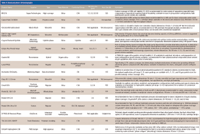
Table II: Reversed-phase chromatography
SFC has been generating interest. especially in pharmaceutical preparative separations' laboratories. Originally, it was of interest for the purification of enantiomeric compounds but its speed and "safe," easily removed mobile phase (that is, carbon dioxide) have extended its application to other compound types. Sepax Technologies (Newark, Delaware) introduced a family of polar SFC columns, mostly in HPLC dimensions.

Table III: Size exclusion columns
Reversed-Phase Chromatography
As usual, many new reversed-phase columns were introduced at Pittcon 2008 (see Table II). If one also adds all the reversed-phase columns covered in the new series (Table I), in specialty columns (Table IV), and in the prep chromatography section, one can see clearly the dominance of this operational mode. Over 50 new reversed-phase columns were added to the huge numbers that already exist from past introductions. Silica-based bonded phase columns dominated the introductions again this year but a few hybrid, silica hydride, and polymeric columns were on the scene.
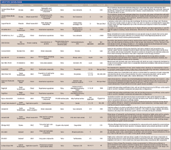
Table IV: HPLC specialty columns
The most popular reversed-phase bonded phase always has been the C18 (octadecylsilane) phase, and this year it proved to be true once again with 26 C18 columns being introduced in all categories. However, this phase is not always the optimum for all separations, and C4, C8, polar-embedded C8 and C18, C18 AQ (aqueous), phenyl-hexyl, phenyl, diphenyl, mixed alkyl-ion exchange, pentylfluorophenyl, organosilica hybrid, silica-hydride, and cyanopropyl phases were made available by various suppliers to present selectivity alternatives. The HILIC columns that have some hydrophobic interaction possibilities are found in Table IV.
One of the more exciting introductions at Pittcon 2008 was the Chromolith FastGradient column by Merck KGaA (Darmstadt, Germany). Although silica-based monoliths have been available for nearly a decade, the 4.6-mm i.d. columns required too high of a flow rate (3–5 mL/min) to get reasonable separation times and certainly flow was too high for interfacing to a mass spectrometer. The problem was that the silica rod monoliths were first synthesized outside of the column. As the silica goes through the polymerization and drying process, the rod shrinks in its diameter and length. Merck scientists made a breakthrough a half dozen years ago and were able to encapsulate the silica rod with PEEK polymer making a tight fit around the silica rod and thereby negating wall effects. Up until now, the smallest diameter of silica rods was 3.0 mm, which required flow rates still too high for electrospray ionization mass spectrometry (ESI-MS); the silica monoliths still were shunned somewhat by mass spectroscopists. This year, the Merck scientists were able to make silica rods with the proper initial dimensions to shrink to 2.0-mm outer diameter to be encapsulated successfully. Both Merck and Phenomenex (Torrance, California), who licenses the Merck monolith technology, introduced 50 mm × 2.0 mm silica monoliths at Pittcon. Now LC–MS users will have a column that can be interfaced more easily to their "detector." In addition, the new 2.0-mm i.d. configuration also will save solvent for conventional LC–UV users. Of course, the biggest advantage of the monolith technology is the lower pressure drop compared with particulate-based columns of the same performance level. Thus, longer columns can be used if high plate counts are required. To illustrate the performance of the Chromolith FastGradient silica monolith column, Figure 1 shows the 2.5-min separation of several antihistamine standards at a flow rate of 1.0 mL/min using a water–acetonitrile (both containing 0.1% trifluoroacetic acid) mobile phase. The column efficiency was quite good with low tailing factors. Although detection was by UV absorbance, the flow rate is within the range of application for many electrospray LC–MS interfaces.
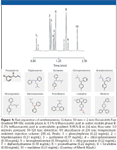
Figure 1
Noted in Table II are quite a number of introductions of small-particle columns with sub-2-μm and 2–3 μm particles. Both particle sizes are smaller than the popular 3–3.5 μm sizes. However, because column efficiency increases as the particle size decreases, one can achieve faster separations by shortening the column and can maintain the resolution by decreasing the particle size concurrently. Some companies prefer to endorse porous particle sizes between 2 and 3 μm in diameter. Because the particle diameter is larger than the sub-2-μm particles, the pressure drop is lower but efficiency is better than the more popular 3–3.5 μm particles. So columns of 2.0-, 2.2-, 2.3-, 2.4-, and 2.8-μm average particle diameter made their appearance this Pittcon. An example of the use of a 2.3-μm column is depicted in Figure 2, in which a TSKgel ODS-140HTP column (Tosoh Bioscience, Montgomeryville, Pennsylvania) was used to resolve a complex mixture of peptides in a beta-lactoglobulin tryptic digest using gradient elution. Two gradient times were used to show that such a digest can be separated partially in a few minutes without going to sub-2-μm columns. Of course, a slower gradient will result in increased peak capacity.
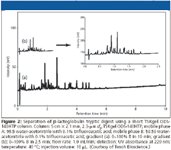
Figure 2
In recent years, there has been a trend in developing silica-based columns with extended upper pH limits. Bare silica gel itself will begin to solubilize at a pH value around 8–9 depending upon the solvent, type of buffer, and temperature. By bonding carbon phases to the silica with high coverage and exhaustive endcapping, the upper pH range can be extended to perhaps 10. By using organosilica chemistry, bidentate bonding, and polymer-coatings, the range can be further extended to 11–12. This year several additional columns with pH stability up to 12 were introduced.
With the increasing use of MS detection, stationary phase bleed is of increasing concern. When UV-only detection was used, the popular C8 and C18 alkylsilane phases contained no chromophore, and slight bleeding did not result in a problem. However, for full-scan MS detection, column bleed can be observed as silicone-containing ions that can interfere with compounds of interest. This year, more low-bleed columns were introduced at Pittcon.
Ion-Exchange and Ion Chromatography
In addition to the ion-exchange columns introduced as part of a family (Table I) and mixed mode columns shown in Table IV, three companies — Dionex (Sunnyvale, California), Bio-Rad Laboratories (Hercules, California), and Shodex/Showa Denko (New York, New York) — introduced new ion-exchange columns. All of these columns were based upon polymeric packings; in general, silica gel-based packings do not seem to stand up to the rigorous mobile phase conditions often used in ion-exchange separations.
The Dionex ProSwift columns consisted of two polymeric monolithic stationary phases, a quaternary amine for strong anion exchange chromatography (ProSwift SAX-1) and sulfonic acid functionality with strong cation exchange capability (ProSwift SCX-1). These columns are recommended for the high-resolution separation of large biomolecules. A positive aspect of monolith columns is that they display a low operating pressure at high flow rates. The anion column is supplied in a microbore format (50 mm × 1.0 mm), while the cation column is in a more conventional analytical format (50 mm × 4.6 mm). Just as conventional polymeric HPLC columns show a wide pH range and long lifetimes, polymeric monolith columns do also.
Dionex also extended its IonPac line of stationary phases with the introduction of the IonPac AS24, a supermacroporous 7 μm, hydroxide-selective, anion-exchange column with alkanol quaternary ammonium functionality and a relatively high ion-exchange capacity of 140 microequiv/g (250 mm × 2 mm column). Synthesized by a novel aggregate monolith technology, this polystyrene–divinylbenzene (PS-DVB)-based polymeric material with 55% crosslinking has a pore size of 2000 Å and is recommended for the separation of haloacetic acids in high ionic strength matrices before MS detection, according to the U.S. EPA Method 553.
The IonPac AS24 column has been found to work also in 2D ion chromatography for bromate determinations at submicrogram-per-liter concentrations in municipal and bottled natural mineral waters using preconcentration and suppressed conductivity detection. This application shown in Figure 3 is the second-dimension separation on the IonPac AS24 column after an initial first-dimension separation on a 4-mm IonPac AS19 column. A small portion of the first-dimension separation is captured on a concentrator column, then eluted to the AS24 anion-exchange column, where bromate is resolved from neighboring anions. The two-dimensional separation can measure even trace bromate in high ionic strength mineral water samples.
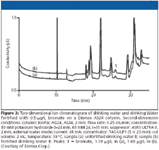
Figure 3
The Shodex Tetra DEAE weak anion exchanger column, available in 35- and 50-mm lengths and 2.0- and 4.6-mm internal diameters, is a 2.5-μm polymeric particle that is claimed to be the first polymer-based column for UHPLC. The pressure rating for this column is 4500 psi or higher, and it is designed to provide analysis times 10 times lower than that typical of conventional ion-exchange HPLC columns. The pH operating range for the first phase in a new family of phases to be introduced later in the year, typically of polymeric columns, goes from pH 2 to pH 12.
Bio-Rad's UNO columns were the first polymeric monolith columns on the market and have been improved over the years. The Continuous Bed matrix has the ability to run at high flow rates with low back pressure. This allows rapid separations of biomolecules to be obtained on medium-pressure as well as high-pressure chromatographs. The company specializes in ion-exchange monoliths. Due to the flow-through pores in the UNO columns, allowing easy access of biomolecules to the ionic functional groups, the binding capacity is quite high, especially when compared with nonporous packings of low surface area. Expanding this technology further, Bio-Rad has introduced UNOsphere S cation and UNOsphere Q acrylamido-based, hydrophilic polymeric ion-exchange materials for preparative and process applications. The support particles, around 80 μm and 120 μm in diameter, are prepared in a single-step polymerization process used to prepare the UNO monolithic columns. The incorporation of the sulfonic acid (S) and the quaternary amine ligand (Q) into the matrix occurs during polymerization. These macroporous (>2000 Å pore size) packings give rise to high binding capacities and fast binding kinetics. The rugged particles can withstand pH values from 1–14 and can be cleaned in-place using high salt (1 M sodium chloride) and corrosive reagents (1 M sodium hydroxide or hydrochloric acid), when necessary.
Size-Exclusion Chromatography
In the past few years, only a few new size exclusion chromatography (SEC) columns have been introduced at Pittcon. As depicted in Table III, this year a larger than normal number were submitted: seven new columns or column series from four companies. Three of the columns were for use in aqueous mobile phases, one in organic mobile phases, but three could be used in either environment. The latter is quite a change from previous generations that could only be used in a single mobile phase for fears of dewetting or swelling–shrinking.
Those columns suitable for use in aqueous, organic, or mixtures of the two were introduced by Varian Polymer Labs (Amherst, Massachusetts) and Jordi FLP (Bellingham, Massachusetts). Such columns are recommended for analysis of polar samples that are not suitable for conventional SEC columns, such as cationic polymers and certain water-soluble polymers. A similar column that has cationic functionality recommended for cationic polymers was introduced by Tosoh. The presence of the cationic surface eliminates cationic adsorption on the surface by ion repulsion.
SEC columns usually come in a variety of pore sizes to cover a wide molecular weight (MW) range. For the analysis of an unknown polymer, analysts must sometimes purchase a number of columns to make sure that they can cover the entire MW range. Because these polymeric columns are rather expensive, for screening purposes, a single column of mixed packings or packings with different pore sizes within a single particle can serve to point the user to single column. Then, if the screening shows that a single pore size is adequate for a particular polymer sample, only a single additional column should be purchased and not a whole set. Such columns were introduced at Pittcon 2008 as shown in Table III.
Specialty HPLC Columns
Specialty columns are HPLC columns that have been developed for specific separations that are difficult to achieve on a standard column. However, sometimes manufacturers will use a standard column but test it specifically for a certain class or compounds and provide a recommended set of chromatographic conditions. In some cases, the specialty column comes as part of a "total solution" kit with reagents, standards and method. Most specialty columns will be delivered with a test chromatogram from an analysis performed at the factory before shipment and some are guaranteed for a specific separation. Table IV shows the 21 specialty columns that were presented at Pittcon 2007. Silica gel–based columns were again a distinct majority but polymer-based columns were introduced to cover a wider pH range
As depicted in Table IV, the biggest single specialty column introduction by far was for the hydrophilic interaction chromatography (HILIC) mode. A total of 12 of the 22 new specialty columns were for this separation mode. HILIC is a separation technique for highly polar analytes that gets around some of the problems associated with reversed-phase chromatography such as low retention or phase collapse (dewetting). HILIC uses a polar stationary phase such as bare silica gel, polar bonded phase (for example, diol), or certain mixed-mode or zwitterionic phases. Operating conditions usually requires a high percentage of a nonpolar mobile phase, similar to the requirements for normal-phase chromatography. However, unlike normal phase, which uses nonpolar solvents such as hexane and methylene chloride and tries to exclude water from the mobile phase, HILIC requires some water in the mobile phase to maintain a stagnant enriched water layer on the packing surface into which analytes may selectively partition. In addition, water-miscible organic solvents are used. Under HILIC, polar analytes are well retained and are eluted in order of increasing hydrophilicity. HILIC is especially favored by mass spectroscopists since ionization efficiency is often enhanced in organic solvents and the presence of low or no buffer salt compared with reversed-phase chromatography. At Pittcon 2008, HILIC columns types included mixed mode (alkyl-diol, alkyl-carboxyl, C18-strong cation, C18-amide, phenyl-amino, aromatic-cyano, alkyl hydroxyl amine, and some proprietary) and zwitterionic (phosphorylcholine and sulfobetaine) phases. To illustrate the advantage of HILIC compared with ion-pair reversed-phase chromatography, Figure 4 shows the separation of glycine and glycylglycine on a C18 column by itself using a 20 mM phosphatase buffer (pH 2.5) (Figure 4a), the same C18 column using the same phosphatase buffer containing 5 mM sodium 1-octanesulfonate (ion pair reagent) (pH 2.5) (Figure 4b) and a Cosmosil HILIC column using acetonitrile: 10 mM ammonium acetate buffer (60:40) (Figure 4c). Although the C18 column will separate the two compounds with ion-pair reagent, many shy away from using ion pair since column equilibration is slow, columns often deteriorate in the presence of ion-pair reagents, and it involves additional mobile phase preparation. The HILIC separation, shown in Figure 4c, uses only a simple mobile phase and provides excellent separation without the use of an ion pair reagent.
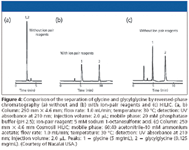
Figure 4
Chiral separations are still in the forefront especially in the pharmaceutical industry. Separations using HPLC and SFC can be achieved by a variety of chiral stationary phases (CSPs). Seven new chiral columns were introduced at Pittcon 2008 (Table IV). The most popular are those based on modified polysaccharides (amylase- or cellulose-based) phases, either coated or immobilized on rigid silica gel particles. The latter are more recent and could be more popular in the future since the CSPs can be used in a wider variety of solvents. There is also a movement towards smaller particle size packings to provide higher resolution and faster separation speeds.
Specialty columns for polynuclear aromatic hydrocarbons (PAHs), proteins, and carbohydrates were also introduced this year. The separation of PAHs is an important in environmental and food safety analysis. The United States Environmental Protection Agency has designated 16 PAHs on their Priority Pollutant list that is indicative of PAH pollution. A number of methods were devised for the analysis of these PAHs in various matrices. These methods are becoming the world standard for PAH analysis in air (EPA method (TO-13), drinking water (EPA 550.1 and ASTM 4657), wastewater (EPA 610), and solid waste (EPA 8310). Reversed-phase HPLC with UV and fluorescence detection is the preferred analysis method. To resolve some of the more difficult pairs of PAHs, the shape selectivity of polymeric C18 phases has provided a better separation and the use of a sub-2-μm column has speeded up the analysis to just over 5 min, as shown in Figure 5 using a simple water–methanol mobile phase gradient. Besides the 16 EPA PAH compounds, there is one additional peak, toluene, in the chromatogram.
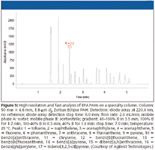
Figure 5
Acknowledgment
I would like to thank the manufacturers and distributors that kindly furnished the requested information in advance of Pittcon 2008, thus, allowing a timely report on new product introductions. For those manufacturers who would like to be considered for inclusion into Pittcon 2009 coverage, please send the name of the primary company contact, the mailing address, FAX number, and e-mail address to Patrick Kempf, Managing Editor, LCGC, c/o Advanstar Communications, 485 Rte. 1 South, Bldg. F, Iselin, NJ 08830,
Attn.: Pittcon '09 "Column Watch."
Ronald E. Majors
"Column Watch" and "Sample Prep Perspectives" Editor Ronald E. Majors is Senior Scientist, Columns and Supplies Division. Agilent Technologies, Inc. Life Sciences and Chemical Analysis, Wilmington, Delaware and a member of LCGC's editorial advisory board. Direct correspondence about this column to "Sample Prep Perspectives,"LCGC, Woodbridge Corporate Plaza, 485 Route 1 South, Building F, First Floor, Iselin, NJ 08830, e-mail lcgcedit@lcgc-mag.com
References
(1) R.E. Majors, LCGC 25(3), 248–266 (2007).
(2) R.E. Majors, LCGC 25(4), 340–358 (2007)
(3) S.J. Lehotay, K. Mastovska, A.R. Lightfield, J-AOAC-Int., 88(2), 615–629 (2005).
4) S.J. Lehotay, Proc. AOAC Annual Meeting, St. Louis, MO USA (2004)
(5) M. Annastassiades, QuEChERS — A Mini-Multiresidue Method for the Analysis of Pesticide Residues in Low-Fat Products, www.quechers.com/
6) R.E. Majors, LCGC 26(1), 16–28 (2008).
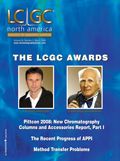
Silvia Radenkovic on Building Connections in the Scientific Community
April 11th 2025In the second part of our conversation with Silvia Radenkovic, she shares insights into her involvement in scientific organizations and offers advice for young scientists looking to engage more in scientific organizations.
Regulatory Deadlines and Supply Chain Challenges Take Center Stage in Nitrosamine Discussion
April 10th 2025During an LCGC International peer exchange, Aloka Srinivasan, Mayank Bhanti, and Amber Burch discussed the regulatory deadlines and supply chain challenges that come with nitrosamine analysis.
Polysorbate Quantification and Degradation Analysis via LC and Charged Aerosol Detection
April 9th 2025Scientists from ThermoFisher Scientific published a review article in the Journal of Chromatography A that provided an overview of HPLC analysis using charged aerosol detection can help with polysorbate quantification.












